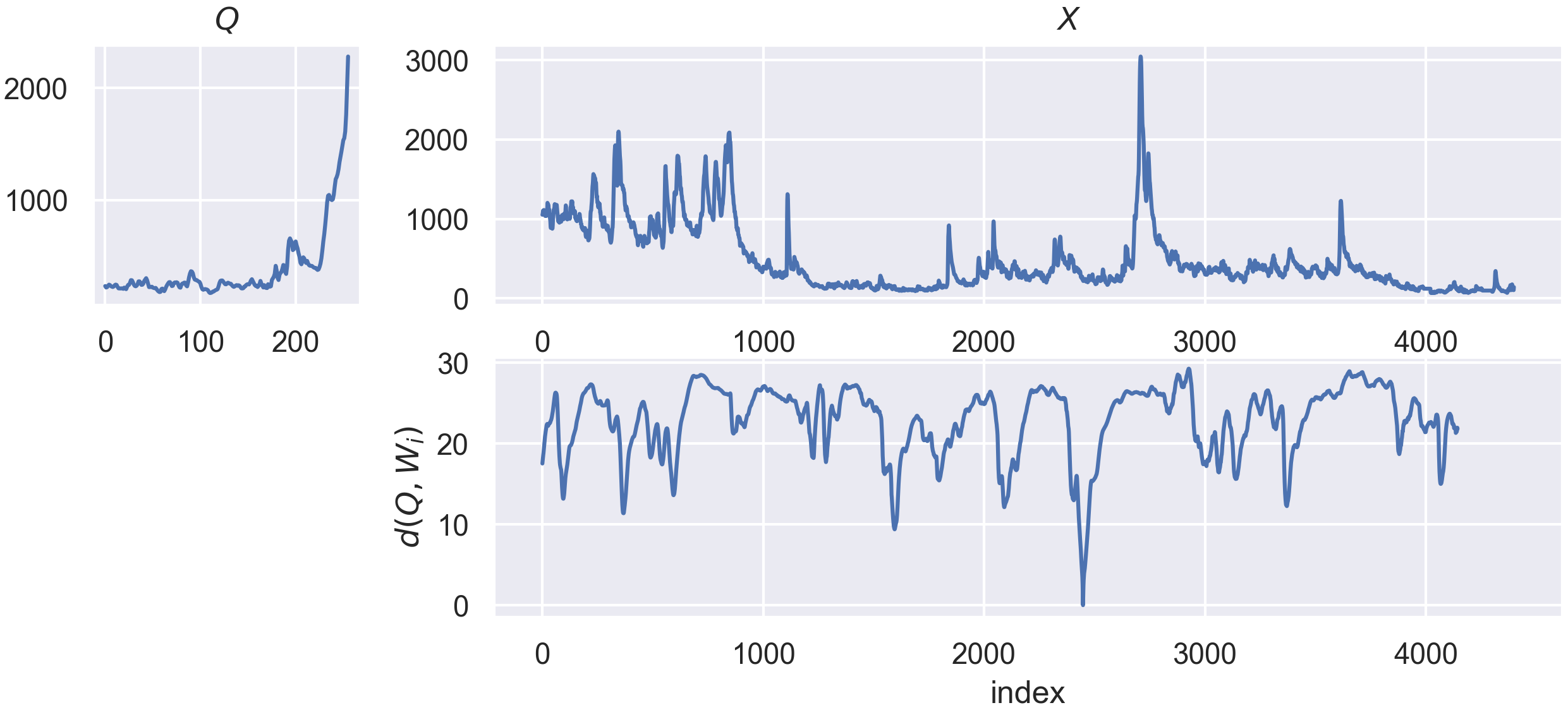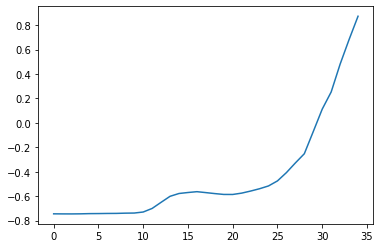Time Series Similarity search with aeon#
The goal of Time Series Similarity search is to asses the similarities between a time series, denoted as a query q of length l, and a collection of time series, denoted as X, which lengths are superior or equal to l. In this context, the notion of similiarity between q and the other series in X is quantified by similarity functions. Those functions are most of the time defined as distance function, such as the Euclidean distance. Knowing the similarity between q and
other admissible candidates, we can then perform many other tasks for “free”, such as anomaly or motif detection.

Similarity search Notebooks#
This notebook gives an overview of similarity search module and the available estimators. The following notebooks are avaiable to go more in depth with specific subject of similarity search in aeon:
Expected inputs and format#
Available estimators#
All estimators of the similarity search module in aeon inherit from the BaseSimilaritySearch class, which requires the following arguments: - distance : a string indicating which distance function to use as similarity function. By default this is "euclidean", which means that the Euclidean distance is used. - normalize : a boolean indicating whether this similarity function should be z-normalized. This means that the scale of the two series being compared will be ignored, and
that, loosely speaking, we will only focus on their shape during the comparison. By default, this parameter is set False.
Another parameter, which has no effect on the output of the estimators, is a boolean named store_distance_profile, set to False by default. If set to True, the estimators will expose an attribute named _distance_profile after the predict function is called. This attribute will contain the computed distance profile for query given as input to the predict function.
To illustrate how to work with similarity search estimators in aeon, we will now present some example use cases.
Top-K similarity search#
We will use the GunPoint dataset for this example, which can be loaded using the load_classification function.
[47]:
import numpy as np
from matplotlib import pyplot as plt
from aeon.datasets import load_classification
# Load GunPoint dataset
X, y = load_classification("GunPoint")
classes = np.unique(y)
fig, ax = plt.subplots(figsize=(20, 5), ncols=len(classes))
for i_class, _class in enumerate(classes):
for i_x in np.where(y == _class)[0][0:2]:
ax[i_class].plot(X[i_x, 0], label=f"sample {i_x}")
ax[i_class].legend()
ax[i_class].set_title(f"class {_class}")
plt.suptitle("Example samples for the GunPoint dataset")
plt.show()

The GunPoint dataset is composed of two classes which are discriminated by the “bumps” located before and after the central peak. These bumps correspond to an actor drawing a fake gun from a holster before pointing it (hence the name “GunPoint” !). In the second class, the actor simply points his fingers without making the motion of taking the gun out of the holster.
Suppose that we define our input query for the similarity search task as one of these bumps:
[2]:
q = X[3, :, 20:55]
plt.plot(q[0])
plt.show()

Then, we can use the TopKSimilaritySearch class to search for the top k matches of this query in a collection of series. The training data for TopKSimilaritySearch can be seen as the database in which want to search for the query on.
[44]:
from aeon.similarity_search import TopKSimilaritySearch
# Here, the distance function (distance and normalize arguments)
top_k_search = TopKSimilaritySearch(k=3, distance="euclidean")
mask = np.ones(X.shape[0], dtype=bool)
mask[3] = False
# Use this mask to exluce the sample from which we extracted the query
X_train = X[mask]
# Call fit to store X_train as the database to search in
top_k_search.fit(X_train)
best_matches = top_k_search.predict(q)
print(best_matches)
[(195, 26), (92, 23), (154, 22)]
The similarity search estimators return a list of size k, which contains a tuple containing the location of the best matches as (id_sample, id_timestamp). We can then plot the results as:
[45]:
fig, ax = plt.subplots(figsize=(20, 5), ncols=3)
for i_k, (id_sample, id_timestamp) in enumerate(best_matches):
# plot the sample of the best match
ax[i_k].plot(top_k_search._X[id_sample, 0], linewidth=2)
# plot the location of the best match on it
ax[i_k].plot(
range(id_timestamp, id_timestamp + q.shape[1]),
top_k_search._X[id_sample, 0, id_timestamp : id_timestamp + q.shape[1]],
linewidth=7,
alpha=0.5,
color="green",
label="best match location",
)
# plot the query on the location of the best match
ax[i_k].plot(
range(id_timestamp, id_timestamp + q.shape[1]),
q[0],
linewidth=5,
alpha=0.5,
color="red",
label="query",
)
ax[i_k].set_title(f"best match {i_k}")
ax[i_k].legend()
plt.show()

Generated using nbsphinx. The Jupyter notebook can be found here.